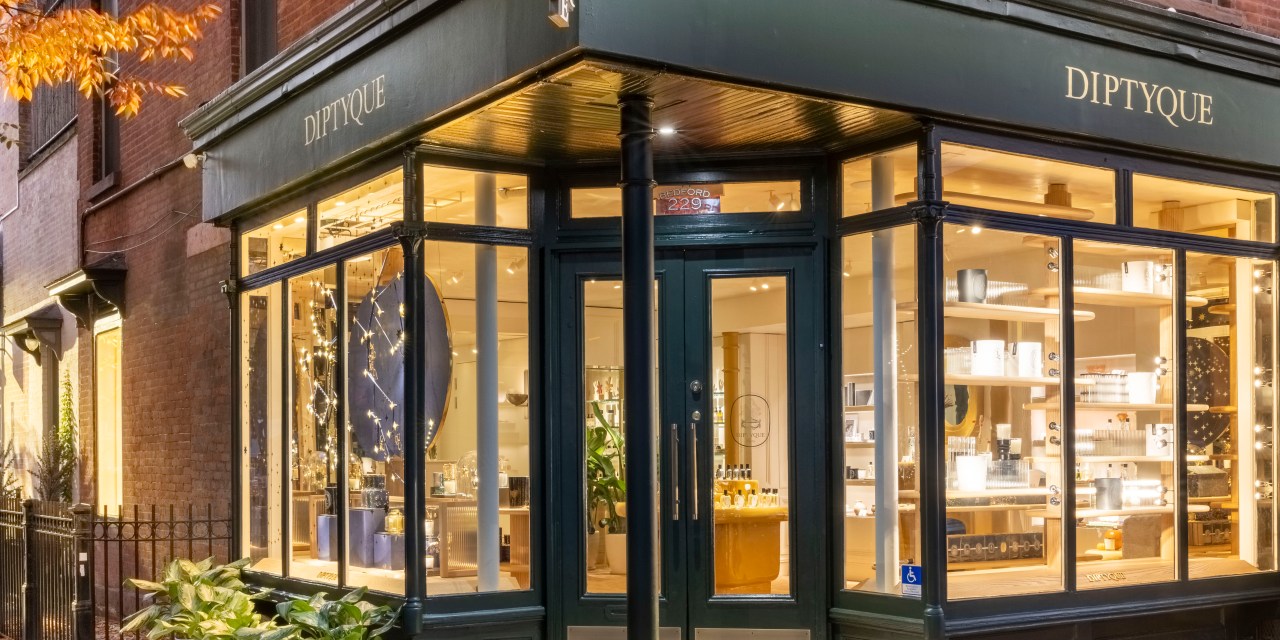French fragrance brand Diptyque plans more standalone stores across the U.S.

Diptyque has become a staple in high-end department stores, but now the French fragrance brand wants to build a more direct relationship with customers. After experiencing triple-digit year-over-year DTC sales growth throughout the pandemic, Diptyque is focusing on opening more standalone stores in the U.S. while remodeling some of its other boutiques.
Diptyque was founded in 1961 in Paris as a fragrance and candle shop. But the brand debuted a redesigned DTC website in 2019, targeting its biggest markets of North America and China. During the pandemic, Diptyque experienced triple-digit year-over-year DTC sales growth, with DTC accounting for over 60% of the brand’s U.S. sales. Now, as more people return to shopping in stores, Diptyque is re-investing in opening more of its own physical locations. Today, the company operates over 90 boutiques globally — up from 70 in 2018. The figure is set to surpass 100 locations by the end of 2022.
Julien Gommichon, president of Diptyque Americas, told Modern Retail that for a fragrance brand, a standalone store presence “is crucial” both for brand awareness and product experience. For Diptyque, stores also serve a different purpose from the wholesale availability at retailers like Nordstrom and Saks Fifth Ave. The brand also operates some stores-within-stores within Bloomingdale’s.
“We see the boutiques as our authoritative footprint where we can most closely engage our customers,” Gommichon said. “They’re also a way of going back to the brand’s roots,” he said, since it began as a concept store selling fabrics and textiles.
The brand has become synonymous with its line of luxury candles, which retail for $40 to $72 per jar depending on size. But now Diptyque has ambitions to become a full-fledged fragrance and home decor brand. In February 2021, Diptyque launched a home decor collection featuring tableware like trays, coasters and decorative objects, which the company plans to continue to expand. Opening more of its own stores gives Diptyque a way to highlight its growing array of merchandise.
The new set of shops are part of Diptyque’s multi-year rollout strategy, in which the company has also been converting stores into more inviting spaces reflective of the brand’s French roots. The first store to open under this banner was New York’s Nolita neighborhood location, which reopened in mid-2021.
With these new stores, the company is targeting high-traffic shopping hubs near other luxury beauty and lifestyle brands. And much of this activity is coming ahead of the busy holiday season.
Ad position: web_incontent_pos1
In October, Diptyque reopened its redesigned Brooklyn location in Williamsburg. Diptyque also opened a new boutique on Fillmore Street in San Francisco; the store features Parisian-inspired black and white tiled floors and a stone fireplace — which has become the brand’s flagship design centerpiece.
“Every store is uniquely designed, so we don’t use the same furniture and artwork in every store,” Gommichon said. “This helps give it the boutique feel that the brand originally began as.”
Last month, the brand also unveiled a holiday pop-up in Washington D.C.’s Georgetown neighborhood. The pop-up is specifically designed around the brand’s space-themed Map of Stars holiday collection. Following the holiday season, this location will close and be reopened as a permanent shop in March 2023. Another standalone shop, inside The Forum Shops at Caesar in Las Vegas, is also set to open by the end of 2022. This fall, Diptyque also announced a pop-up collaboration with The Ritz-Cartlon, where it will sell exclusive gift sets at select hotel shops throughout the holiday season.
Diptyque also hopes that the combination of unique stores, exclusive products and bespoke touches like gift wrap and fragrance refill stations will continue to fuel its DTC growth.
“We have large collections of scents that people want to smell before trying, and stores are a big part of that,” Gommichon said, adding that going forward, Diptyque stores will act as the biggest customer acquisition tool. On the other hand, the company views its e-commerce channel as an outlet for targeting existing customers who already have go-to scents.
Ad position: web_incontent_pos2
Until now, Diptyque’s North America segment has been focused on major cities like New York and Los Angeles. However, with the U.S. market becoming the brand’s biggest outside of China in recent years, Gommichon said more stores are expected in the coming year. “We’re looking at secondary markets like Chicago, Dallas, Houston, Atlanta, Miami and even North Carolina,” Gommichon added.
David Schneidman, Director at Alvarez & Marsal Consumer Retail Group, said with e-commerce having dominated shopping in the past couple of years, brands are now re-establishing their brick-and-mortar experiences.
“Consumers shop and search in an omnichannel lens, so having some sort of physical presence is essential to continue to sustainable growth,” Schneidman said. For legacy brands like Diptyque, that means maintaining relationships with wholesale partners like department stores while also growing their own footprint.
For Diptyque, its growing number of standalone stores will also help house much of Diptyque’s growing collections of products.
“We launched a new personal fragrance two years ago, Orpheon — and the category has been a big area of focus for us, and we’ll continue to lean into,” Gommichon said. “Now that we’re moving more into home decor, we want to showcase more of these selections that shoppers can touch and feel at our stores,” Gommichon said.

